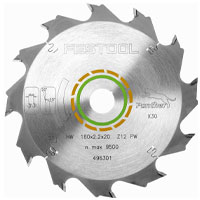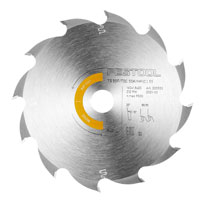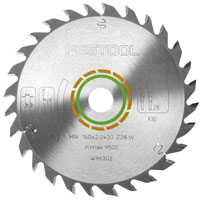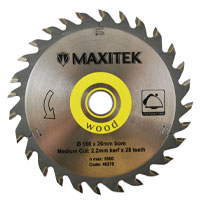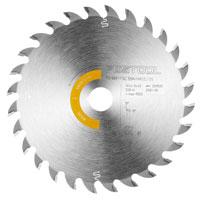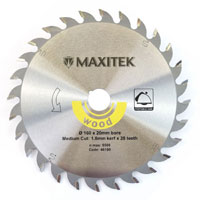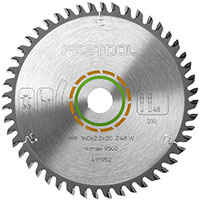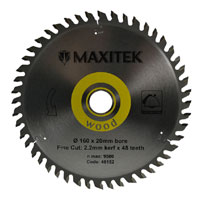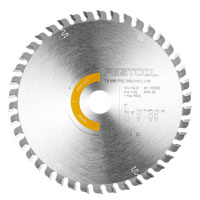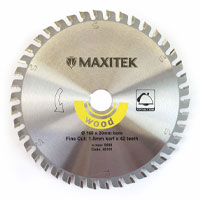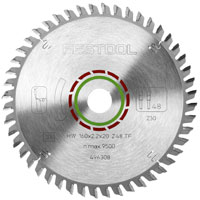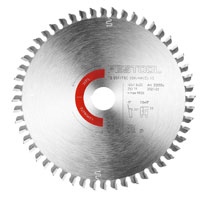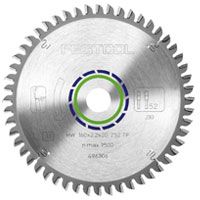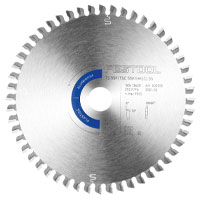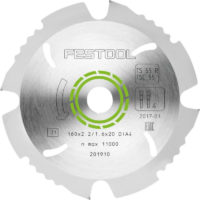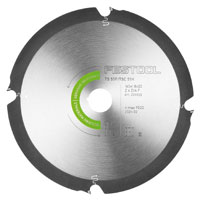Festool Plunge Saws Review [2025]
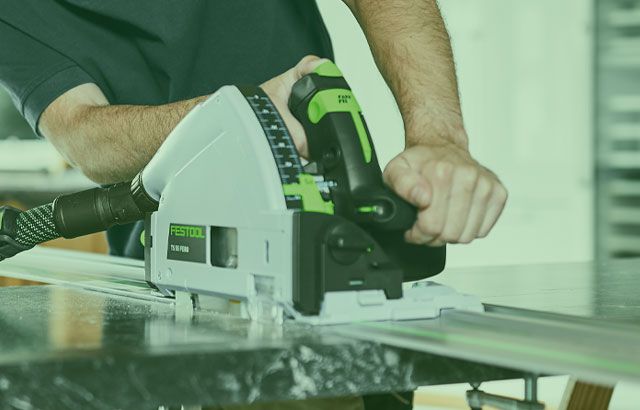
This Festool Plunge Saw review looks at how the Festool plunge-cut saw has evolved over the years, with the introduction of unique features and benefits, that has made precision performance plunge saws synonymous with Festool. We also explore the different types of saw blades available, helping you determine what saw blade is compatible with which machine for your specific application requirements.
History of Festool

Festool was founded in 1925 by Albert Fezer and Gottlieb Stoll. The business initially concentrated on repairing wood processing machinery and making structural modifications, by converting plain bearings to ball bearings.
The first tools they developed were under the original brand ‘Fezer & Stoll’. The name was shortened to ‘Festo’ in 1933 and then expanded again at the start of the 1990’s to include the term ‘Tooltechnic’ – to disassociate the professional woodworking tools company from Festo Pneumatic.
A final brand name change took place in 2000, when Festo Tooltechnic became Festool… the name we all know today.
Introduction of the Festool ‘Track Saw’
The first generation of Festool guide rails were first brought to market in 1962, used in conjunction with a traditional portable circular saw. The original guide rail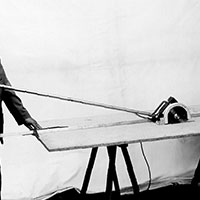 was replaced by a new aluminium version in 1980; redesigned at the time to accompany the very first ‘Festo’ branded plunge saws – the AXF 45 and AXF 55 – launched in the same year.
was replaced by a new aluminium version in 1980; redesigned at the time to accompany the very first ‘Festo’ branded plunge saws – the AXF 45 and AXF 55 – launched in the same year.
The ingenious product designers had identified that a portable plunge-cut saw, together with a guide rail, could make cuts with unprecedented levels of precision – whilst significantly reducing set-up times.
Evolution of the Festool Plunge Saw
Early Festool Plunge Saws
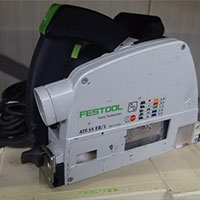
The very first Festo plunge saws evolved throughout the 1980’s, from the AXF series to AT 55E and then the ATF 55E, which looked remarkably like the current Festool plunge saw models we see on sites and in workshops nowadays.
An innovative splinterguard was also added to the edge of the guide rail. This simple but effective ‘rubber lip’ was designed to create a splinter-free cutting edge and also make it incredibly easy to position the tool on the scribe mark.
The guide rail and plunge-cut saw combination was starting to become indispensable to joiners, woodworkers, carpenters, kitchen fitters, exhibition stand fitters, interior finishers, drywall installers, as well as parquet and floor layers.
Game-Changing TS 55 Festool Plunge Saws
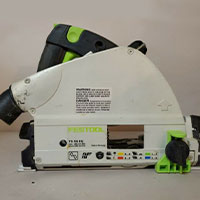
The introduction of the now renowned TS 55 plunge-cut saw in 2003, led to the track saw system gaining popularity across the entire construction industry. As the TS 55 series of plunge-cut saws evolved, key elements were added to future generation machines, with many still remaining today:
The first-generation TS 55 featured:
- Attachable splinterguard, ensuring a smooth and splinter-free finish on both sides of the cutting line when used with a guide
- rail.
- Detachable ‘plug-it’ power cord for easy device changeover and problem-free cable replacement.
- ‘Fast Fix’ blade changing system, with a tool-less lock mechanism, for easy saw blade change and increased safety.
In addition, the second-generation TS 55 R also featured: 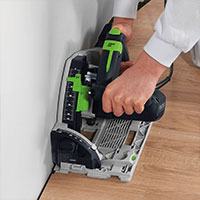
- Flush housing design that allowed the saw to be used close to walls at a minimum distance of just 12mm.
- Transparent sliding window ensured the operator had a clear view of the cutting line, for maximum accuracy during the sawing process.
- Spring-loaded riving knife prevented the saw from jamming and made it easier to insert the blade into existing cuts.
- Ability to make bevel cuts from -1° to +47° – previously it was only 0° to +45°.
- Dual cutting depth adjustment indicator that clearly displayed the selected cutting depth when working with and without a guide rail.
The third generation and latest TS 55 F model retains all of these features – plus: 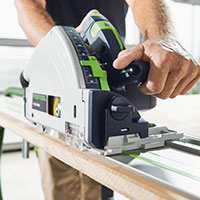
- Cuts up to twice as fast as previous TS 55 models.
- Increases saw blade service life… in other words, the blade lasts longer.
Once more, Festool have raised the bar with the launch of their latest TS 55 F plunge-cut saw, which landed in April 2021. The notable upgrades since its inception back in 2003, are still featured on the latest version – with additional usability and performance enhancements added.
Festool boldly declare that the new unit will cut up to twice as fast as the previous models and the saw blade will stay sharper for longer. How can this be?
The fundamental difference between old and new is based around the saw blade. The latest TS 55 F features a thinner kerf blade, reduced from 2.2mm to 1.8mm. When you think about it, a narrower blade will certainly cut through the material faster and reduced friction would undoubtedly increase the blade’s service life. Logic would also suggest that a thinner kerf blade would apply much less strain to the saw’s motor – leading to improved reliability. But will the narrower blade vibrate or wobble, leading to a compromised finish?
Festool maintain that the new 1.8mm kerf, used in conjunction with the latest TS 55 F plunge saw, delivers an equally impressive straight and stable cut, without compromising cutting performance in any way whatsoever. I have to say that after using the new Festool plunge saw personally, I wholeheartedly agree with them.
Cordless Festool Plunge Saws
With the phenomenal growth in battery-powered tools across the construction industry, it was only a matter of time before Festool launched a cord-free version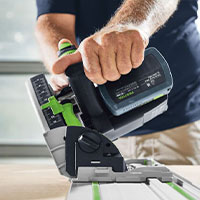 of their renowned track saw. In 2014, the very first cordless Festool plunge saw was launched – the TSC 55 R. The new battery powered tool was identical to its corded counterpart in almost every way… except it required two 18V batteries instead of a mains power lead of course.
of their renowned track saw. In 2014, the very first cordless Festool plunge saw was launched – the TSC 55 R. The new battery powered tool was identical to its corded counterpart in almost every way… except it required two 18V batteries instead of a mains power lead of course.
Like the earlier models within the TS 55 series of plunge-cut saws, the new battery edition utilised the same 2.2mm kerf blade as the mains machine. Although the cutting performance was comparable for both mains and cordless, the ‘standard kerf’ blade would have almost certainly compromised battery runtimes.
It’s conceivable that the creative minds within Festool’s research and development department may have considered improving battery life when developing the latest range of plunge saws. Like the new corded TS 55 F, the brand new TSC 55 K cordless saw – also launched in April 2021 – works with the same 1.8mm kerf saw blade.
The speed and increased service life benefits exist on the new battery-powered unit – plus battery runtimes are greatly improved, not to mention all the other TS 55 series upgrades I alluded to earlier in the article. You’ll find all these features on the latest TSC 55 K cordless plunge-cut saw… plus this fabulous new power tool has an additional unique feature…
Exclusive to the new cordless 18V Festool plunge-cut saw is kickback stop! Kickback can be the most common cause of serious injury when using a plunge
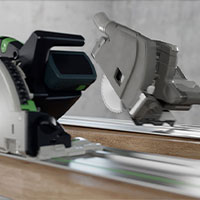
saw. Should kickback occur when plunging into the workpiece, the new TSC 55 K plunge saw stops immediately. This new safety feature prevents the backwards motion of the saw, not only minimising risk of injury to the operator, but also protecting the workpiece and guide rail from damage.
Kickback stop can also be deactivated for individual cuts where required. You’re no doubt wondering why the clever kickback stop function is only featured on the new cordless TS 55 K plunge-cut saw, and not the new TS 55 F corded model. This is due to the specific electronic requirements of the saw’s motor, to enable kickback stop to work.
Are Saw Blades Interchangeable Between Old & New Festool Plunge Saws?
Thinner kerf saw blades have traditionally been reserved for cordless saws, but Festool have turned this theory on it’s head with their new track saw line-up. We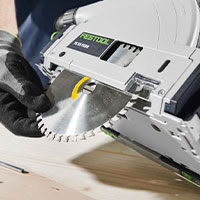 asked the question as to whether the new plunge saws will accept the old 2.2mm kerf saw blades and the old versions work in conjunction with the new 1.8mm kerf saw blades.
asked the question as to whether the new plunge saws will accept the old 2.2mm kerf saw blades and the old versions work in conjunction with the new 1.8mm kerf saw blades.
The official answer from the Festool headquarters in Germany is ‘No’!
The reasons for this have been explained as follows:
- The inner flange that holds the saw blade is machined perfectly to the kerf thickness, meaning that if a 1.8mm blade was used on the old version, the outer flange would simply not clamp the saw blade. Even if you did somehow manage to get the blade to clamp, the riving knife on the older models would be too thick for the narrower 1.8mm kerf cut.
- Conversely, if a 2.2mm blade was used on the new version, the thicker blade would lead to insufficient tightening of the locking screw – resulting in the saw blade not being safely and securely fixed into place. Even if you did manage to get the outer flange to hold the blade, the additional torque generated from a thicker blade would interfere with the kickback stop technology on the new TSC 55 K cordless plunge saw – meaning the saw would constantly cut out during use.
In the interest of clarity, the table below shows exactly what saw blade suits which machine:
| Application | Older Models TS55 R, TSC55 R, TS 55, ATF 55, AP55 (Plunge Saws Pre-April 2021) |
Latest Models TS55 F, TSC55 K, HK55, HKC55 (Plunge Saws April 2021 onwards) |
| Wood Fast rip cut in solid wood, board materials and building panels. |
HW 160×2.2×20 PW12
Code: 46053 – |
HW 160×1.8×20 PW12
Code: 46291 – |
| Wood Universal medium cut in solid wood, board materials and building panels. |
HW 160×2.2×20 W28
Code: 46259 –
Code: 46275 – |
HW 160×1.8×20 W28
Code: 46292 –
Code: 46160 – |
| Wood Fine and clean cut in solid wood, board materials as well as veneered and coated panels. |
HW 160×2.2×20 W48
Code: 46253 –
Code: 46152 – |
HW 160×1.8×20 WD42
Code: 46293 –
Code: 46161 – |
| Laminate Cutting laminate and coated panels, melamine hard panels (Trespa), solid surfaces (Corian), mineral materials and phenolic-resin-bonded laminates. |
HW 160×2.2×20 TF48
Code: 46308 – |
HW 160×1.8×20 TF52
Code: 46294 – |
| Aluminium/Plastics Cutting aluminium composite panels, non-ferrous metals, copper, brass, phenolic-resin-bonded laminates, hard plastics, hard PVC, acrylic glass, aluminium panels and profiles. |
HW 160×2.2×20 TF52
Code: 46260 – |
HW 160×1.8×20 F/FA52
Code: 46295 – |
| Abrasive Materials PCD polycrystalline diamond blade for cutting cement-bonded and gypsum-bonded chipboard and fibreboard building materials. |
HW 160×2.2×20 F4
Code: 46099 – |
HW 160×1.8×20 F4
Code: 46296 – |
The Festool guide rail profile remains unchanged, so both old and new plunge saws are still compatible with exactly the same guide rails.
Festool Plunge Saws: Summary
Track or plunge saws have been available in the UK for a number of years. I recall Protrade stocking the Holz-Her Mosquito in the 1980’s – I’m showing my age now! Back then, approximately one plunge saw was sold to every ten traditional circular saws.
Forward-wind to the 2020’s, these statistics have flipped on their head, with plunge saws outselling conventional circular saws by at least ten to one. Festool are without doubt the market leaders in this power tool category, although Mafell might have something to say about that.
In truth, you won’t be disappointed in whichever brand you choose.

Joint Managing Director, Protrade
Craig has over 30 years of experience at Protrade, working in various departments including sales, procurement, and marketing, and ultimately becoming Managing Director in 2008. Following the merger of Protrade and Joinery Fit-Out Supplies in 2018, Craig is now the joint MD of the company.

